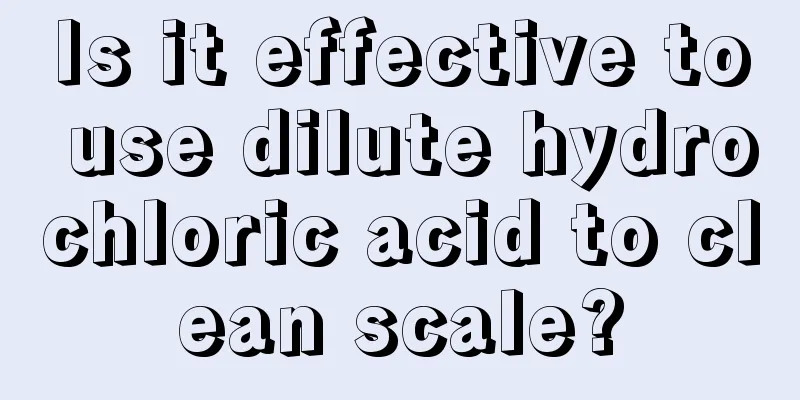Is it effective to use dilute hydrochloric acid to clean scale?

|
Cleaning with dilute hydrochloric acid is a relatively effective method to remove scale, but you must note that hydrochloric acid is a strong acid. If you want to use hydrochloric acid for cleaning, you must dilute it before use, and try not to let your hands come into direct contact with hydrochloric acid. 1. Hydrochloric acid: Hydrochloric acid is a strong acid. Since the hydrochlorides of most metals are easily soluble in water, hydrochloric acid has a strong scale-dissolving ability and can quickly dissolve rust, copper rust, aluminum rust, and carbonate scale. However, hydrochloric acid is extremely corrosive to many metal materials and appropriate corrosion inhibitors must be added. The presence of chloride ions in hydrochloric acid has both the advantage of promoting the rapid and active dissolution of metal corrosion products and the disadvantage of causing local destruction of the passivation film of passive materials and inducing pinhole corrosion. Ordinary stainless steel, aluminum and alloy materials are passive materials that are stable only by the protection of the oxide passivation film produced on the surface. Once the passivation film is destroyed, the material will be severely corroded. For ordinary stainless steel and aluminum, Cl- ions are active ions that can locally destroy the passivation film and are the main factor causing pinhole corrosion. Therefore, hydrochloric acid should not be used 2. Sulfuric acid: Concentrated sulfuric acid has strong oxidizing properties and can passivate iron, but it does not have the effect of dissolving scale. The concentration of sulfuric acid during cleaning is generally below 15% and is no longer oxidizing. Since the solubility of some sulfates is not high, the rust and scale dissolving rate of sulfuric acid is relatively slow. However, dilute sulfuric acid is non-volatile and will not produce acid mist at the cleaning site. The cleaning speed can be increased by increasing the temperature. Therefore, sulfuric acid is often used as a cleaning agent when removing scale such as iron oxide. 3. Nitric acid: Nitrates have a large solubility, so nitric acid has a good removal effect on rust, copper rust, and various types of dirt. Especially when removing dirt from the surface of stainless steel, since nitric acid is oxidizing, it can make the stainless steel self-passivate and hardly cause corrosion to the stainless steel. However, nitric acid is highly corrosive to low-carbon steel, so a reliable corrosion inhibitor must be selected. 4. Phosphoric acid: Calcium phosphate has a low solubility and is rarely used to clean scale. However, under certain specific conditions, such as high temperature and high humidity, phosphoric acid can form water-soluble coordination compounds with metal ions, or directly convert rust into a protective phosphating film. Therefore phosphoric acid is only used under certain specific conditions. 5. Hydrofluoric acid: Hydrofluoric acid is a weak acid, but it has a strong ability to dissolve iron oxide, which is mainly due to the special effect of fluoride ions. Hydrofluoric acid is also the only effective pickling agent for dissolving silicon. |
<<: What is the method to remove scale from a thermos bottle
>>: What are the items in the routine blood test
Recommend
Does the water light needle have a moisturizing effect?
Although various injections are very popular on t...
What tea can lower blood sugar?
As people's living standards improve, the foo...
What should I do if my stomach hurts after eating spicy food?
Eating spicy food will not only make your tongue ...
What are the prevention methods for nasopharyngeal cancer
In recent years, nasopharyngeal cancer has become...
I feel a sense of pressure on my forehead
If you feel any discomfort in your body, you shou...
Are deodorant insoles harmful to the body?
Most people will feel that their shoes become ver...
How long does it usually take for brain cancer to go from early stage to late stage
Fever in the late stage may indicate a more serio...
What is liver ultrasound?
We all know that if there is a problem with the i...
How long can you live with kidney tumor and kidney cancer
Kidney cancer is a very harmful disease. It bring...
Can massaging the acupuncture points on the nose prevent disease?
We know that there are many acupoints on the body...
What is the best time to treat hamartoma
I believe everyone is very eager to know the answ...
How to treat leukocytopenia
The number of platelets in the human body has a n...
10 diseases that parents can pass on to their children
Could disease be innate? This is not groundless. ...
What tests can detect ovarian cancer
Ovarian cancer is a type of gynecological maligna...
The bottom of the nose is black like a mustache
When a person looks at another person, he or she ...









